| |
 |
 |
 |
|
 |
 |
 |
 |
 |

|
 |
 |
|
|
|
 |
Ferns Diversified in Shadow of Flowering Plants
|
 |
| |
 Belying the popular notion of ferns as delicate, lacy relics surmounted by the evolution of flowering plants, biologists have presented evidence for a much different scenario. Their studies indicate that when flowering plants, or angiosperms, evolved some 144 million years ago, ferns took advantage of ecological niches in the new angiosperm forests to diversify into a far richer array of species. The study offers a new insight into the critical period in evolution when the rise of flowering plants sparked a dramatic increase in species diversity that eventually fostered the rise of birds, bees and mammals, including humans.
Belying the popular notion of ferns as delicate, lacy relics surmounted by the evolution of flowering plants, biologists have presented evidence for a much different scenario. Their studies indicate that when flowering plants, or angiosperms, evolved some 144 million years ago, ferns took advantage of ecological niches in the new angiosperm forests to diversify into a far richer array of species. The study offers a new insight into the critical period in evolution when the rise of flowering plants sparked a dramatic increase in species diversity that eventually fostered the rise of birds, bees and mammals, including humans.
Image courtesy: Jim Wallace, Duke University Photography
Read the full story. ... Posted
3/31/04
|
 |
National Science Foundation Signs Cooperative Agreement with Joint Oceanographic Institution to Lead U.S. Efforts in Integrated Ocean Drilling Program
|
 |
| |
 The National Science Foundation has signed a cooperative agreement with the Joint Oceanographic Institutions, a consortium of 20 academic institutions, to lead U.S. participation in the Integrated Ocean Drilling Program (IODP) through the U.S. Science Support Program (USSSP). USSSP will support U.S. scientists in all IODP platforms, encouraging broad community involvement in all phases of the drilling effort. The award is for $15 million over three years. "We look forward to active participation in the exciting new IODP by the U.S. science community," said James Yoder, director of NSF's division of ocean sciences. "IODP will explore the deep biosphere, sub-seafloor ocean, processes and effects of environmental change, and solid earth cycles and dynamics. Using new tools not available in the predecessor ocean drilling programs, scientists anticipate exciting results in these areas."
The National Science Foundation has signed a cooperative agreement with the Joint Oceanographic Institutions, a consortium of 20 academic institutions, to lead U.S. participation in the Integrated Ocean Drilling Program (IODP) through the U.S. Science Support Program (USSSP). USSSP will support U.S. scientists in all IODP platforms, encouraging broad community involvement in all phases of the drilling effort. The award is for $15 million over three years. "We look forward to active participation in the exciting new IODP by the U.S. science community," said James Yoder, director of NSF's division of ocean sciences. "IODP will explore the deep biosphere, sub-seafloor ocean, processes and effects of environmental change, and solid earth cycles and dynamics. Using new tools not available in the predecessor ocean drilling programs, scientists anticipate exciting results in these areas."
Image courtesy: Texas A&M University
Read the full story. ... Posted
3/31/04
|
 |
Polymer Chemists Assemble Nanowires and Nanoemitters
|
 |
| |
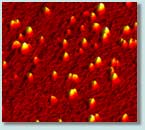 At the annual meeting of the American Chemical Society last weekend, two groups of polymer scientists from Carnegie Mellon University's Department of Chemistry were scheduled to describe novel nanostructures, created with chemical methods, which may lead to new generations of electronic devices and materials. Chuanbing Tang, a graduate student working with Professor Tomasz Kowalewski, described carbon-based structures created from polymer mixtures applied to a substrate. Kowalewski's group, funded as part of an NSF Nanoscale Interdisciplinary Research Team, believes this technique can be adapted to construct nanosensors, electron emitters for flat panel displays, and solar cells. Richard McCullough, dean of the Mellon College of Science, described his group's newest conducting polymers. McCullough and coworkers, also supported by NSF, have developed methods for attaching chemical "caps" to a class of conducting polymers they first synthesized in 1992.
At the annual meeting of the American Chemical Society last weekend, two groups of polymer scientists from Carnegie Mellon University's Department of Chemistry were scheduled to describe novel nanostructures, created with chemical methods, which may lead to new generations of electronic devices and materials. Chuanbing Tang, a graduate student working with Professor Tomasz Kowalewski, described carbon-based structures created from polymer mixtures applied to a substrate. Kowalewski's group, funded as part of an NSF Nanoscale Interdisciplinary Research Team, believes this technique can be adapted to construct nanosensors, electron emitters for flat panel displays, and solar cells. Richard McCullough, dean of the Mellon College of Science, described his group's newest conducting polymers. McCullough and coworkers, also supported by NSF, have developed methods for attaching chemical "caps" to a class of conducting polymers they first synthesized in 1992.
Image courtesy: Tomasz Kowalewski, Carnegie Mellon University
Read the full story. ... Posted
3/30/04
|
 |
Glacial Records Depict Ice Age Climate in Synch Worldwide
|
 |
| |
 An answer to the long-standing riddle of whether the Earth's ice ages occurred simultaneously in the Southern and Northern hemispheres is emerging from glacial deposits found in the high desert east of the Andes. The work, reported in the March/April issue of the Geological Society of America Bulletin, is important because it reveals that ice ages were global in nature, a fact scientists had trouble determining due to the difficulty of precisely dating the jumble of debris--sand, gravel, clay and boulders--that ice-age glaciers leave in their wakes. The new work suggests ice ages occurred worldwide, in part, because of the sluggish redistribution of solar energy through the world's oceans punctuated by repeated, rapid cooling of the Earth's atmosphere. An answer to the long-standing riddle of whether the Earth's ice ages occurred simultaneously in the Southern and Northern hemispheres is emerging from glacial deposits found in the high desert east of the Andes. The work, reported in the March/April issue of the Geological Society of America Bulletin, is important because it reveals that ice ages were global in nature, a fact scientists had trouble determining due to the difficulty of precisely dating the jumble of debris--sand, gravel, clay and boulders--that ice-age glaciers leave in their wakes. The new work suggests ice ages occurred worldwide, in part, because of the sluggish redistribution of solar energy through the world's oceans punctuated by repeated, rapid cooling of the Earth's atmosphere.
Image courtesy: NASA Landsat Project Science Office and USGS EROS Data Center
Read the full story. ... Posted
3/24/04
|
 |
Nation's Best Mathematics and Science Teachers Visit Washington to Receive Presidential Award
|
 |
| |
 Pickles, Oreos, cell phone billing plans and Barbie dolls have everything to do with raising achievement in secondary mathematics and science, according to some of the nation's top teachers in these subjects. Innovation, humor, expert knowledge of their subject and an ability to inspire student creativity are among the qualities common to the 95 mathematics and science teachers honored this week with the Presidential Awards for Excellence in Mathematics and Science Teaching, the nation's highest commendation for work in the classroom. The National Science Foundation administers the awards program for the White House. Pickles, Oreos, cell phone billing plans and Barbie dolls have everything to do with raising achievement in secondary mathematics and science, according to some of the nation's top teachers in these subjects. Innovation, humor, expert knowledge of their subject and an ability to inspire student creativity are among the qualities common to the 95 mathematics and science teachers honored this week with the Presidential Awards for Excellence in Mathematics and Science Teaching, the nation's highest commendation for work in the classroom. The National Science Foundation administers the awards program for the White House.
Image: White House photo by Tina Hager
Read the full story. ... Posted
3/19/04
|
 |
Virtual Screening Lab Zeroes in on New Drugs
|
 |
| |
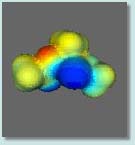 Researchers at Rensselaer Polytechnic Institute have come up with computational tools that serve as a virtual screening lab to help chemists weed through millions of possible drug candidates even before they dirty their first test tube. Chemist Curt Breneman, mathematician Kristin Bennett, and computer scientist Mark Embrechts developed faster and more accurate techniques for describing molecules and combined them with next-generation neural networks and learning methods as part of the Drug Discovery and Semi-Supervised Learning (DDASSL) project. Funded by a $1.2 million National Science Foundation Knowledge and Distributed Intelligence award, the DDASSL (pronounced "dazzle") project has spawned a number of descendants. Researchers at Rensselaer Polytechnic Institute have come up with computational tools that serve as a virtual screening lab to help chemists weed through millions of possible drug candidates even before they dirty their first test tube. Chemist Curt Breneman, mathematician Kristin Bennett, and computer scientist Mark Embrechts developed faster and more accurate techniques for describing molecules and combined them with next-generation neural networks and learning methods as part of the Drug Discovery and Semi-Supervised Learning (DDASSL) project. Funded by a $1.2 million National Science Foundation Knowledge and Distributed Intelligence award, the DDASSL (pronounced "dazzle") project has spawned a number of descendants.
Image: Curt Breneman, RPI
Read the full story. ... Posted
3/19/04
|
 |
Celebrating Excellence in Science, Technology, and Mathematics Education (ESTME) Week -- March 14-20, 2004
|
 |
| |
 To celebrate ESTME Week, the Department of Education and the National Science Foundation have joined representatives from public and private organizations to create activities and events to help parents, teachers, and professionals excite K-12 students about science and mathematics. The activities during ESTME Week reach beyond the "pencil and paper" aspects of education to the hands-on realm of experimentation and investigation. The week brings students face to face with the opportunity to discover and explore their world through math and science learning. Featured activities include the Science Summit, Classrooms of the Future Expo, and "Ask a Scientist or Engineer." To celebrate ESTME Week, the Department of Education and the National Science Foundation have joined representatives from public and private organizations to create activities and events to help parents, teachers, and professionals excite K-12 students about science and mathematics. The activities during ESTME Week reach beyond the "pencil and paper" aspects of education to the hands-on realm of experimentation and investigation. The week brings students face to face with the opportunity to discover and explore their world through math and science learning. Featured activities include the Science Summit, Classrooms of the Future Expo, and "Ask a Scientist or Engineer."
Read the full story. ... Posted
3/16/04
|
 |
New Radar System May Help Airplanes Avoid In-Flight Icing
|
 |
| |
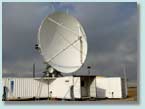 The buildup of ice on airplanes in flight is a major winter hazard for small and commuter planes. But scientists at the National Center for Atmospheric Research (NCAR) in Boulder, Colo., are testing a new system this month that may pinpoint water droplets in clouds that cause icing, potentially enabling pilots to avoid dangerous areas. The system, known as S-Polka, combines two existing radars that use different wavelengths. By studying the differences between the images that are reflected back to each radar, scientists hope to find tiny water droplets that are difficult to distinguish using either radar alone. The project is funded by the National Science Foundation, which is NCAR's primary sponsor, and the Federal Aviation Administration. The buildup of ice on airplanes in flight is a major winter hazard for small and commuter planes. But scientists at the National Center for Atmospheric Research (NCAR) in Boulder, Colo., are testing a new system this month that may pinpoint water droplets in clouds that cause icing, potentially enabling pilots to avoid dangerous areas. The system, known as S-Polka, combines two existing radars that use different wavelengths. By studying the differences between the images that are reflected back to each radar, scientists hope to find tiny water droplets that are difficult to distinguish using either radar alone. The project is funded by the National Science Foundation, which is NCAR's primary sponsor, and the Federal Aviation Administration.
Image: Carlye Calvin, UCAR
Read the full story. ... Posted
3/10/04
|
 |
Understanding Ground Zero; Beyond September 11th researcher presentations now available on the web
|
 |
| |
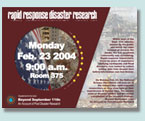 Rapid-response researchers, driven by years of experience studying earthquake and flood disasters, rushed to collect critical data from Ground Zero within days of the September 11th attacks. Unseen by the public and below the radar screens of many in the media, the U.S. academic community was scrambling. On Monday, Feb. 23, NSF hosted six of the nation's top rapid-response researchers to report on their experiences at Ground Zero, highlighted the concerns facing disaster researchers and shared their results as collected in the recent compilation, Beyond September 11th: An Account of Post-Disaster Research. Rapid-response researchers, driven by years of experience studying earthquake and flood disasters, rushed to collect critical data from Ground Zero within days of the September 11th attacks. Unseen by the public and below the radar screens of many in the media, the U.S. academic community was scrambling. On Monday, Feb. 23, NSF hosted six of the nation's top rapid-response researchers to report on their experiences at Ground Zero, highlighted the concerns facing disaster researchers and shared their results as collected in the recent compilation, Beyond September 11th: An Account of Post-Disaster Research.
Image: Sara Raimo, National Science Foundation
Photos: FEMA
Read the full story. ... Posted
3/9/04
|
 |
Rare "Tumbleweed" Survives Antarctic Conditions: Rover Designed to Seek Water in Ice Caps on Other Worlds
|
 |
| |
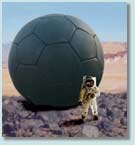 A balloon-shaped robot explorer that one day could search for water on other planets has survived some of the most trying conditions on planet Earth during a 70-kilometer (40-mile), wind-driven trek across Antarctica. The Tumbleweed Rover, which is being developed at NASA's Jet Propulsion Laboratory (JPL) in Pasadena, Calif., left NSF's Amundsen-Scott South Pole Station on Jan. 24, completing its roll across Antarctica's polar plateau roughly eight days later. Along the way, the beach-ball-shaped device, roughly two meters (six feet) in diameter, used the global Iridium satellite network to send information about its position, the surrounding air temperature, pressure, humidity and light intensity to a JPL ground station. A balloon-shaped robot explorer that one day could search for water on other planets has survived some of the most trying conditions on planet Earth during a 70-kilometer (40-mile), wind-driven trek across Antarctica. The Tumbleweed Rover, which is being developed at NASA's Jet Propulsion Laboratory (JPL) in Pasadena, Calif., left NSF's Amundsen-Scott South Pole Station on Jan. 24, completing its roll across Antarctica's polar plateau roughly eight days later. Along the way, the beach-ball-shaped device, roughly two meters (six feet) in diameter, used the global Iridium satellite network to send information about its position, the surrounding air temperature, pressure, humidity and light intensity to a JPL ground station.
Image showing artist's concept of Tumbleweed courtesy: NASA/JPL-Caltech
Read the full story. ... Posted
3/3/04
|
 Top of Page Top of Page
|
|
|
 |
 |
 |
 |
 |
 |
 |
 |
|
 |
 |
 |
|
|

